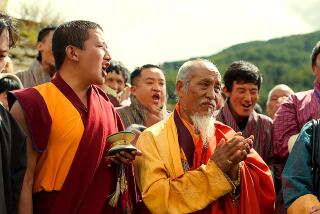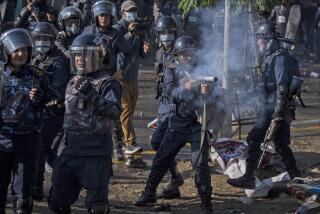From the archives: Tibet’s Hunger to Be Free Symbolized by Dalai Lama
LHASA, Tibet -- “ Dalai Lama picture? Dalai Lama picture?” was the incessant request that foreign tourists visiting Tibetan monasteries in recent years heard from maroon-robed monks and nomadic yak-herder or peasant pilgrims.
But these days Tibetans no longer need to beg foreigners for the pictures. The once-banned photographs of their exiled leader are being openly sold at stands in front of central Lhasa’s Jokhang Temple, the holiest site of Tibetan Buddhism.
“The Chinese say we have religious freedom,” said a Tibetan man, who declined to give his name, “so the Tibetan people are taking such freedom. They can always say, ‘The Dalai Lama is our religious leader. This has nothing to do with politics.’ ”
The Dalai Lama, however, has a great deal to do with politics.
Little more than a month ago, his supporters staged a demonstration near the Jokhang Temple calling for Tibetan independence from China. Paramilitary police fired on the protesters, felling several.
Western tourists who witnessed the Dec. 10 incident said at the time that a monk carrying the banned mountain-and-snow-lion flag of Tibetan independence had been killed, and that one or two other people also appeared to have died.
The man carrying the flag was a monk from Drepung Monastery who died immediately from a bullet to the head, according to a young monk from another Lhasa area monastery. The monk spoke Thursday with this reporter, the first foreign journalist allowed to visit Tibet since the incident. He said that two other people were seriously injured in the police firing, but that as far as he knew they had not died.
The martyrdom of colleagues in this and two earlier protests has fueled a fervent sense of Tibetan nationalism among young Buddhist monks, and the harsh Chinese tactics in suppressing those pro-independence demonstrations have done nothing to upset a trend toward increased religious activity.
But for now, an appearance of calm has been restored in the Jokhang area. There are larger quantities of religious artifacts and Tibetan handicrafts for sale in the temple area market than has been the case for years. A year ago it was difficult to buy even a tiny pin bearing the Dalai Lama’s picture.
Acts of Worship
Now, every day several thousand pilgrims wind their way through the temple. The women clad in black robes with brightly colored aprons, the men in sheepskin coats, they pour melted yak butter into flaming lamps as acts of worship before Buddhist icons enshrined in side halls of the main temple.
Outside the temple, hundreds of worshipers perform prostrations that they hope will bring them a better life in a future reincarnation.
Stalls in the market area around the temple offer woodblock-print Buddhist scriptures; bright red, green or yellow prayer flags; fragrant leaves that are burned as incense; a variety of Buddhist artworks, and a wide range of Tibetan handicrafts.
There are two police stations in the immediate temple area, and plainclothes officers mingle with the crowd, but the uniformed police presence near the temple and throughout the Tibetan quarter of the city is very light.
This reporter saw two truckloads of police pass through the city Thursday, however, and in the western half of Lhasa, where most Chinese live, uniformed police or soldiers are seen frequently.
The Dec. 10 incident was preceded by two bloody clashes, on March 5 of last year and Oct. 1, 1987. On each of those occasions, pro-independence protests were put down by paramilitary police firing into angry crowds.
Each demonstration has been followed by a sweep of arrests of suspected activists and a period of denial of access to Tibet by Beijing-based correspondents.
The March 5 protest, which came at the end of the annual Monlam festival, is believed to have left at least eight people dead, including protesters and a Chinese policeman. As many as 14 people died in the 1987 clash.
The official New China News Agency reported Thursday that two Tibetan men accused of killing the Chinese policeman in March have been convicted. One was given a suspended death sentence, which could be carried out in two years unless commuted to life imprisonment for good behavior, and the other was sentenced to life imprisonment, the news agency reported.
The news agency said that 22 other participants in the March 5 uprising also were given prison terms.
Lhasa remained calm late into the evening Friday. It was not clear what sort of reaction there might be to the sentences, or even whether news of them was widely known.
Limited Religious Freedom
The policy that Beijing is attempting to carry out in Tibet is quite clear: a limited revival of religious freedom, combined with an absolute ban on pro-independence activities, which are viewed as treason.
In keeping with this policy, which began about a decade ago, major monasteries destroyed during the 1966-1976 Cultural Revolution have been gradually restored. For instance, the official newspaper China Daily reported that the mummified remains of five high Tibetan lamas, desecrated by Red Guards during the Cultural Revolution, have been returned to their sacred resting place, the Great Stupa of the Pashi Lhunpo Lamasery in Xigaze, Tibet. That structure, wrecked by the Red Guards, has been rebuilt and is scheduled to be reopened Sunday.
Although the number of monks at each monastery is still limited to several hundred, the Chinese policy has been flexible enough that strong centers of monastic life have revived at the three great monasteries of the Lhasa area: Sera, Drepung, and Ganden.
Occasional Independence
Despite the placing of what activist monks allege are spies within these monasteries, the Chinese have been unable to control ideological life in them.
“Sera, Drepung and Ganden are all the same,” a young monk said Thursday at Sera Monastery. “They want independence for Tibet. But the Chinese have guns, and the Tibetan people have no guns. All they can do is demonstrate.”
Over the centuries, Tibet has sometimes been part of China and sometimes independent. The Qing Dynasty incorporated Tibet into its empire. But Tibet enjoyed de facto independence from the fall of the Qing Dynasty in 1911 until the Chinese Communists established control of the region in 1951.
Activist Tibetans believe that the protests of the past 16 months--together with the opening of Tibet to Western tourists, who serve as witnesses--have created momentum for their cause.
Many also seem to believe that the Chinese authorities have no choice but to allow gradually increased religious freedom, because a Cultural Revolution-style crackdown on religious activity would only increase anti-Chinese sentiment and add to Beijing’s difficulties in controlling the region.
Anniversaries coming up in February and March may prove to be occasions for further protest.
This year’s Monlam Festival begins next month. Some monks say they are afraid to attend, while others say they may use the occasion for another demonstration.
“If we go, we’ll demonstrate,” a monk at Sera Monastery said Thursday. “Even if they shoot, we’re not afraid.”
Some activists, however, predict that March 17, the 30th anniversary of the Tibetan uprising that led to the Dalai Lama’s exile, is the most likely date for another major demonstration of pro-independence sentiment.
More to Read
Start your day right
Sign up for Essential California for news, features and recommendations from the L.A. Times and beyond in your inbox six days a week.
You may occasionally receive promotional content from the Los Angeles Times.






